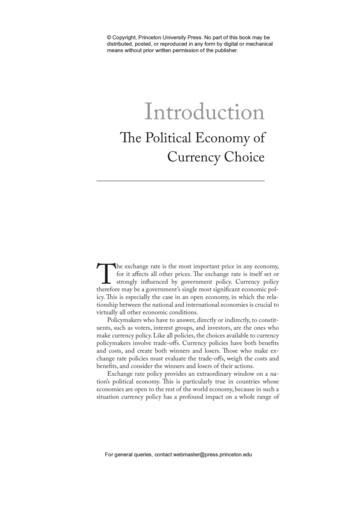Exchange-Rate Systems And Currency Crises
Exchange-Rate Systemsand Currency Crises
Exchange Rates Regimes of theWorld, 1870–2000Feenstra and Taylor: International Economics, First EditionCopyright 2008 by Worth Publishers
Exchange-Rate Practices Floating or Fixed? IMF principles for member nations: No manipulation to prevent effective balance-ofpayments adjustments or unfair competitive gains Act to counter short-term exchange market disorders When members intervene in markets, they shouldtake into account the interests of other members. Exchange-rate practices of IMF members (Table 15.1) Choosing an exchange-rate system (Table 15.2)
Choosing an Exchange-RateSystem Constraints imposed by free capital flows Countries can maintain only two of thefollowing three policies: Free capital flows A fixed exchange rate An independent monetary policy The impossible trinity (Figure 15.1)
Figure 19.6 The Trilemma in ActionFeenstra and Taylor: International Economics,First EditionCopyright 2008 by Worth Publishers
Figure 19.7 Exchange Rate Regimes and Output VolatilityFeenstra and Taylor: International Economics, First EditionCopyright 2008 by Worth Publishers
Figure 19.4 A Theory of Fixed Exchange RatesFeenstra and Taylor: International Economics, First EditionCopyright 2008 by Worth Publishers
Fixed Exchange-Rate System General practice until the 1970s Primarily used by small, developingnations Currencies are anchored to a key currency Developing nations can stabilize the domesticcurrency prices of their imports and exports Exerts restraint on domestic policies and reducesinflation Major key currencies of the world (Table 15.3)
Fixed Exchange-Rate SystemContinued Anchor to a single currency Developing nations with a single industrial-countrypartner Anchoring to a group or basket of currencies Developing nations with more than one major tradingpartner Helps to average out fluctuations Anchoring to the special drawing right (SDR) Basket of four currencies (Table 15.4) Increased stability
Fixed Exchange-Rate SystemContinued Par value and official exchange rate Governments assign their currencies a parvalue in terms of gold or other key currencies Determining official exchange rate Exchange-rate stabilization fund Set up to defend the official rate Purchases and sales of foreign currencies toiron out short-term fluctuations (Figure 15.2) Fundamental disequilibrium
Fixed Exchange-Rate SystemContinued Devaluation Home currency’s exchange value depreciates,counteracting a payments deficit Revaluation Home currency’s exchange value appreciates,counteracting a payments surplus Decisions to be made before implementation Necessity of the step Timing of adjustment Magnitude of adjustment Advantages and disadvantages of fixed rates (Table 15.5)
Bretton Woods System of FixedExchange Rates Adjustable pegged exchange rates (1946-1973) Currencies tied to each other Disequilibrium: Repegging up to 10 percent allowed Par value fixed in terms of gold or the gold content of theU.S. dollar in 1944 Band limits Operational difficulties Conflicting objectivesMagnitude of adjustmentsDifficulties in estimating equilibrium ratesSpeculation
Floating Exchange Rates Currency prices established in the foreignexchange market Without restrictions imposed by governmentpolicies Equilibrium exchange rate equates thedemand for and supply of the home currency
Floating Exchange RatesContinued Achieving market equilibrium Example: Foreign-exchange market in Swissfrancs in the United States (Figure 15.3) Market equilibrium will be established at apoint where the quantities of foreign exchangesupplied and demanded are equal
Floating Exchange RatesContinued Trade restrictions, jobs, and floatingexchange rates Import restrictions will gradually shift jobs fromother industries to the protected industry No significant impact on aggregate employment Short-run employment gains in the protectedindustry will be offset by long-run employmentlosses in other industries
Arguments For and AgainstFloating Rates Advantages SimplicityContinuous adjustment in the balance of paymentsAdverse effects of prolonged disequilibriums are minimizedPartially insulates the home economy from external forcesFreedom to pursue policies that promote domestic balance Disadvantages Unregulated market leads to wide fluctuations in currency values Prohibitively high cost of hedging Flexibility to set independent policies leading to inflationary bias Summarized in Table 15.5
Managed Floating Rates Informal guidelines established by IMF (1973) Based on two concerns Nations intervening in exchange markets– Clean float and dirty float Disorderly markets with erratic fluctuations Under managed floating, a nation: Can alter the degree of intervention Can intervene to reduce short-term fluctuations: Leaningagainst the wind Should not act aggressively with respect to their currencyexchange rates Can choose target rates and intervene to support them
Managed Floating Rates in theShort Run and Long Run Under a managed float Market intervention is used to stabilizeexchange rates in the short run In the long run, a managed float allowsmarket forces to determine exchange rates Example: Theory of a managed float in a twocountry framework (Figure 15.4)
Exchange-Rate Stabilization andMonetary Policy Stabilization requires the central bank to adopt: An expansionary monetary policy to offset currencyappreciation A contractionary monetary policy to offset currencydepreciation Example: Exchange-rate stabilization and monetary policy(Figure 15.5) Long-run effectiveness of using monetary policy tostabilize the exchange value of the currency is limited
Is Exchange-Rate StabilizationEffective? Volatility of foreign-exchange markets Intervention by central banks Intervention supported by central bankinterest rate changes Coordinated intervention Proponents of intervention: Useful when the exchange rate is underspeculative attack May be helpful in coordinating private-sectorexpectations
The Crawling Peg Small, frequent changes in the par value of currency Correct balance-of-payments disequilibriums Used primarily by nations having high inflation rates Proponents Flexibility of floating rates with stability of fixed ratesMore responsive to changing competitive conditionsAvoids changes that are frequently wide of the markFrustrates speculators with their irregularity IMF view Hard to apply this system to industrialized nations whosecurrencies serve as a source of international liquidity
Currency Crises Currency crises or speculative attack A weak currency experiences heavy sellingpressure Indications of selling pressure include: Sizable losses in the foreign reserves held by acountry’s central bank Depreciating exchange rates in the forward market Widespread flight out of domestic currency intoforeign currency or into goods Examples of currency crises (Table 15.6)
Currency CrisesContinued Crisis ends when selling pressure stops Ways to end pressure Devalue the currency Adopt a floating exchange rate Currency crashes: Crises that end in devaluations oraccelerated depreciations Avoiding a currency crash Impose restrictions on the ability of people to buy and sellforeign currency Obtain a loan to bolster the foreign reserves Restore confidence in the existing exchange rate
Sources of Currency Crises Budget deficits financed by inflationWeak financial systemsWeak economyPolitical factorsExternal factorsChoice of an exchange-rate system
Speculators Attack East AsianCurrencies Southeast Asian currency decline led bythe Thai Baht Resistance offered to the depreciationpressure and raising interest rates to makethe Baht attractive Abandoning the dollar peg in July 1997 Long-term effects of abandoning the fixed rate
Capital Controls Government-imposed barriers To foreign savers investing in domestic assets To domestic savers investing in foreign assets Also known as exchange controls
Capital Controls: Advantages Government can influence its paymentsposition Encourage or discourage certain transactionsby offering different rates for foreign currencyfor different purposes Can give domestic monetary and fiscalpolicies greater freedom in their stabilizationroles
Capital Controls: Disadvantages Disadvantages of capital outflows Outflows may increase since confidence inthe government is weakened Restrictions often result in evasion False sense of security for officials Controls on capital inflows often receivemore support
Should Foreign-ExchangeTransactions Be Taxed? Proponents Tax would give traders an incentive to look at longterm economic trends Increased cost of transactions Dampen excess volatility Drawbacks Difficult to determine excesses Burden on countries that are quite rationallyborrowing overseas Difficult to implement
Increasing the Credibility of FixedExchange Rates Currency boards Issues notes and coins convertible into a foreignanchor currency at a fixed exchange rate Backing of the domestic currency must be at least100 percent: Monetary policy on autopilot Benefits of a currency board system (Figure) Concerns Prevents a country from pursuing a discretionary monetarypolicy Susceptible to financial panics - lacks a lender of last resort Creates a colonial relationship with the anchor currency
Currency Board - Argentina Shift to fixed exchange rate and currency boardfollowing hyperinflation in 1970s and 80s Economy hit during the late 1990s Appreciation of the dollarRising U.S. interest ratesFalling commodity prices on world marketsThe depreciation of Brazil’s real Borrow to finance deficits Defaults ended convertibility of pesos into dollars
Dollarization Usage of the U.S. dollar alongside or instead ofthe local currency Partial dollarization and full dollarization Why Dollarize? Credibility and policy discipline Avoiding capital outflows that often precede oraccompany an embattled currency situation Decrease in transaction costs Lower inflation Greater openness
DollarizationContinued Effects of Dollarization – Ecuador Accepting the monetary policy of the Federal Reserve Risk that business cycles might not coincide Federal Reserve is not their lender of last resort Loss of seigniorage Freedom to decide how to spend its tax dollars Ecuador could establish its own tariffs, subsidies, and tradepolicies Constraint: No recourse to printing local currency
DollarizationContinued Implications of Dollarization for the U.S. For each dollar sent abroad, Americans enjoy a onetime increase in the amount of goods and servicesthey are able to consume Effect of opting to hold dollars rather than debt: An interest-free loan from Ecuador Use of U.S. currency abroad might hinder theformulation and execution of monetary policy More pressure on the Federal Reserve to conductpolicy according to the interests of Ecuador
Currency boards Issues notes and coins convertible into a foreign anchor currency at a fixed exchange rate Backing of the domestic currency must be at least 100 percent: Monetary policy on autopilot Benefits of a currency board system (Figure) Concerns Prevents a country from pursuing a discretionary monetary policy
Currency Exchange Setup. Adding Currency Code and Exchange Rates2-1. Editing Currency Exchange Rate2-2. Removing Currency Exchange Rate2-2. Commission Charge Code and Account2-2. Setting Up Commission Charge Code2-4. Setting up System Account2-4. Performing Currency Exchange Transaction. Buy Sell Currency Exchange3-1. Exchange Charge to Account3-2
interest rate or currency exchange rate. Forward Foreign Exchange Contract a contract agreed upon by two entities to buy or sell a certain amount of a currency at a set rate of exchange at a future date. Forward Exchange Rate the price of one currency in terms of another currency for delivery on a specified date in the future. This is the
from an underlying asset which in foreign currency options is the exchange rate. There are two types of foreign currency options, a call currency option and a put currency option. A call option on a particular currency gives the holder the right but not an obligation to buy that currency at a predetermined exchange rate at a particular date and .
Transaction currency The currency in which a transaction originates. Accounting currency The primary currency in which a legal entity maintains its financial records. The accounting currency is stored in the Ledger table. Reporting currency The reporting currency of the ledger. The reporting currency is stored in the Ledger table. It is optional.
Keywords: Exchange Rate Regimes Estimation, Exchange Rate Regimes Classification, Exchange Rate Regimes, Exchange Rate Policies, and Exchange Market Pressure. 1. Introduction In order to make a sound recommendation for a country exchange rate policy, it is valuable to evaluate how well its exchange rate policies have operated in the past.
As we all know currency is a monetary system in general use of a particular country. Because of the intrinsic or absolute value that the currency holds, people started buying or selling currency itself for exchanging of another currency. These concepts gradually built Foreign Exchange Market (FOREX, FX or Currency Market).
The Political Economy of Currency Choice tive exchange rate policy can be, most accept that nominal currency movements have a significant real impact, at least in the short and me-dium run.4 For our purposes, the key point is that policymakers can affect both the exchange rate regime and level of the exchange rate. They can do so
An Introduction to Random Field Theory Matthew Brett , Will Penny †and Stefan Kiebel MRC Cognition and Brain Sciences Unit, Cambridge UK; † Functional Imaging Laboratory, Institute of Neurology, London, UK. March 4, 2003 1 Introduction This chapter is an introduction to the multiple comparison problem in func-























